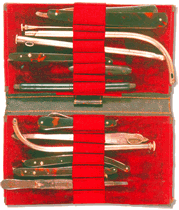1800's Surgical Case

|
Artery forceps: steel; 19th century; 0,8x11,9x1cm
Bistouri: tortoiseshell, brass and steel; 19th century; 0,8x16,2x0,6cm; Aubry
Bistouri: tortoiseshell, brass and steel; 19th century; 0,9x16,5x0,5cm; Aubry
Bistouri: tortoiseshell, brass and steel; 19th century; 0,9x17,5x0,5cm; Aubry
Bellocq's Canula: silver and German silver; 19th century; 0,9x13,5x1cm
Scoop/curette: steel; 19th century; 0,1x13,1x1,1cm; Aubry
Tenaculum: tortoiseshell, brass and steel; 19th century; 0,8x12,3x0,4cm; Aubry
Wood case containing paracentesis needle and spoon: 19th century; 0,7x11,5x0,7cm
Feminine catheter: silver; 1,5x14x0,8cm; Aubry
Bistouri: tortoiseshell, steel; 19th century; 0,8x16,4x0,6cm; Aubry
Lancet: tortoiseshell, steel; 19th century; 1x9x0,3cm; Aubry
Trocars and canula: silver and German silver; 19th century; 0,7x12,9x0,7cm; Aubry
Distal part of a masculine catheter: silver; 0,5x14,5x0,5cm
Razor: tortoiseshell, brass and steel; 19th century; 1x19,7x0,8cm; Aubry. |
Charrière is thought to be the responsible for making usual the manufacture of small pocket dressing cases where a number of surgical instruments were included. Such fact would be practicable through, for example, the segmentation of each instrument. The aim was the easy transportation of the pocket dressing case. When the problem concerning the space for the instruments was solved, it should be chosen light materials and stylized forms.
The chosen case comprises fourteen instruments. Tortoiseshell, wood, silver, German silver, brass and steel are the materials that compose the surgical instruments in such a period that the need of thermal sterilization was unthinkable. It was possible to include all the instruments in such a small spaces due to the incorporation of the blades and tenaculum in their handles. An ordinary look at the instruments of this pocket dressing case could lead us to think that the masculine silver catheter is incomplete. However if we are aware of the manufacturer's aim we tend to look for the proximal extremity inside the instruments. It was possible then to find that extremity in the feminine silver catheter, from which it distinguishes by a spiral movement imposed to the proximal salience of this catheter.



